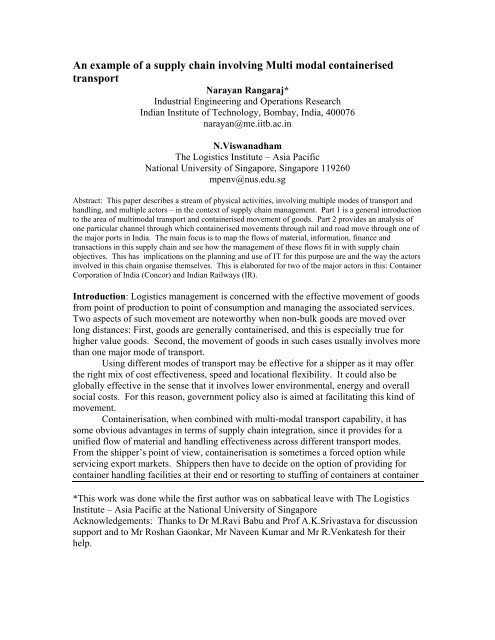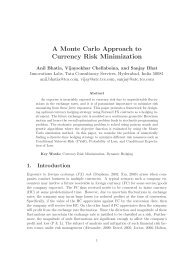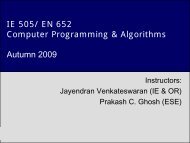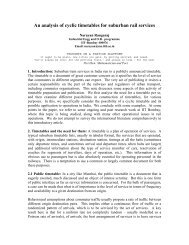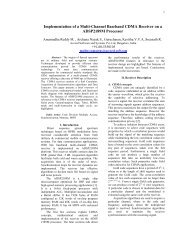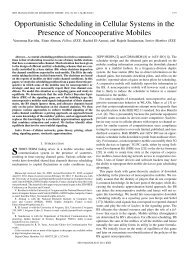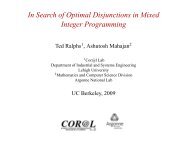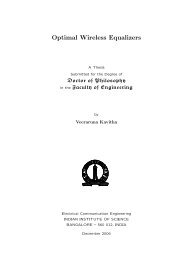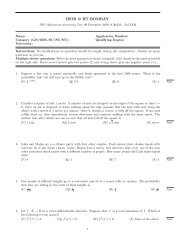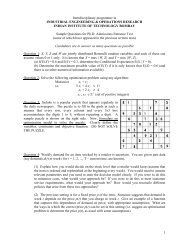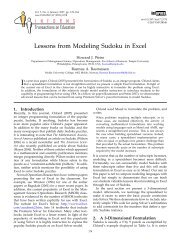PDF Link - Industrial Engineering and Operations Research (IEOR)
PDF Link - Industrial Engineering and Operations Research (IEOR)
PDF Link - Industrial Engineering and Operations Research (IEOR)
- No tags were found...
Create successful ePaper yourself
Turn your PDF publications into a flip-book with our unique Google optimized e-Paper software.
terminals. The former is obviously the prefered (but more expensive) model for door-todooreffectiveness in h<strong>and</strong>ling.From the transporter’s perspective, the multimodal nature of movement invariablymeans that multiple agencies are involved in the activity, one way or another. Anadditional activity is the provisioning of containers themselves, <strong>and</strong> providing forfacilities at which containers can be stored <strong>and</strong> h<strong>and</strong>led. Apart from this, multimodalmovement implies co-ordination across the various agencies, such as freight forwarders,truckers, container stations, sometimes rail, ports, shipping lines, etc. There is often aninfrastructural element in these activities, which have sometimes to be facilitated orprovided by government or other agencies with long time horizon plans in place.Given that this can be quite a challenging task to plan for, we attempt to outlinesome specifics of such multimodal movements, in a particular case of containerisedimport <strong>and</strong> export traffic to <strong>and</strong> from India. The objectives of this paper are:(a) to highlight the role of some of the major players in the business ofmultimodal transport <strong>and</strong> to discuss the accompanying issues in logisticsmanagement(b) to describe one such supply chain involving multimodal movement ofcontainers <strong>and</strong> to identify how various initiatives by organisations haveresulted in supply chain effectiveness.Rangaraj <strong>and</strong> Viswanadham (2001) provides a more detailed discussion of these.PART 11. Multimodal transport: The concept of multimodal transport has been comparativelyslow to get started in India. Containerisation is not yet the major mode of transport, <strong>and</strong>on the roads, open truck movements are quite common. Srivastava <strong>and</strong> Khanna (2001),Ravi Babu (2001) <strong>and</strong> [4] provide a quick, comparative study of developments inmultimodal transport, with special reference to India.Another dimension to the management of multimodal transport activity is that it isdifficult to set norms <strong>and</strong> design systems that are easily accepted. This is because thereare a number of actors <strong>and</strong> there are natural conflicts of firm level economic interest thatare not easy to resolve. For example, the aggregation efficiency that determines onefirm’s cost effectiveness could lead to overall delays <strong>and</strong> inventory costs in another firmsperformance, all as part of the same supply chain. This is quite typical in an integratedsupply chain management environment context, where multi actor co-operation isrequired. A framework for benchmarking multimodal transport activity has beenattempted by Ockwell [3].2. Flows of containerised traffic: The movements of goods by the containerised modehas increased in India over the last few years. This has happened both in theimport/export as well as the internal movement sector. For example, the movement ofgoods through major ports has shown the following indicative trend. The most importantport that h<strong>and</strong>les containerised traffic in India is Jawaharlal Nehru Port Trust (JNPT) <strong>and</strong>the associated Nhava Sheva Inl<strong>and</strong> Container Terminal (NSICT). Traffic h<strong>and</strong>led herehas grown from 11.723 million tonnes in 1998-1999, to 18.573 million tonnes in 2000-
Delhi, <strong>and</strong> the Jawaharlal Nehru Port (JNPT) near Mumbai. These goods are exported orimported at JNPT, <strong>and</strong> are linked to container carrying sea vessels at the port.The goods that are carried in this manner are, of course, part of the overall supplychain of various manufacturers who use this service. The fit of this process in theirsupply chain is one area of interest. At the next level, since Concor acts as a consolidator<strong>and</strong> uses Indian Railways (IR) for the major part of the physical movement, the way inwhich Concor’s supply chain objectives are achieved through IR is another matter ofinterest. At the next level of transaction, since IR is a large organisation, both physically<strong>and</strong> functionally, we examine how this service is operationalised effectively through theinternal divisional (geographical) <strong>and</strong> functional mechanisms.We highlight various dimensions of supply chain management: an assessment offlows in the chain (material, information, money <strong>and</strong> transactions) – in Section 3; the waythese flows fit with the customer focused business needs of the organisations involved –in Section 4; <strong>and</strong> the role of IT, management control <strong>and</strong> organizational structures in themanagement of these flows – in Section 5.We analyse the supply chain from the point of view of Concor as a supply chaindriver, since it has defined the service, takes the responsibility of consolidation of goods,contracts with IR <strong>and</strong> provides performance guarantees to final customers.This study may serve eventually to benchmark this intermodal service againstinternational st<strong>and</strong>ards of supply chain effectiveness. The supply chain described here<strong>and</strong> the emerging role of Concor may set the stage for Third Party Logisitics providers inthe industry. Manufacturers are moving towards such service providers as part of theiroverall move towards logistical effectiveness. For example, see Boyson et al (1999) forsurvey data in this regard. This is possible only with a level of professionalization <strong>and</strong>integrated control over activities like transportation, warehousing <strong>and</strong> storage, <strong>and</strong> alsothe capability to integrate into manufacturing activity at the level of scheduling <strong>and</strong>inventory management.Emergence of this supply chain: Even from an integrated supply chain point of view,one has to make a choice as to the set of activities that can be reasonably managed, <strong>and</strong>analysed. It makes sense to consider this segment of movement (Tughlakabad to JNPT)as a supply chain, since one end - the port - is a natural point of separation of activities, asof now. Although there are agencies which would attempt to provide door to doorshipments across the world, those processes would also be segregated for operationalcontrol at the port interface. This is because of factors such as customs regulations,uncertainty in port operations <strong>and</strong> lack of fully integrated information systems acrossports <strong>and</strong> other modes.Another major reason is that movements of ships carrying containers would bedetermined by factors larger than that of a single shipper’s schedule, since the economiesof scale are of a different level. For example, a truck may carry one or two TEU (twentyfoot equivalent unit) containers or one FEU (forty foot equivalent unit) container, acontainer train may carry 70 to 100 TEUS, whereas a shipping vessel may carry in therange of 2000 TEUs. So as of now, it makes sense to plan for this supply chain as anentity <strong>and</strong> then attempt to interface with the onward supply chain from the port. Shipschedules can be viewed as determining some constraints on the timing of shipments thatmanufacturers place <strong>and</strong> perhaps their manufacturing activities.
The design of this supply chain relies on the fact that there is a viable stream oftraffic between the two areas, achieved by aggregation of a number of different goodsprovided by different customers. We use the term customer to refer to the shipper ofgoods who would use directly or indirectly, Concor, IR <strong>and</strong> other agencies for thepurpose of movement of goods. Our discussion revolves around how this stream ofgoods movement <strong>and</strong> its associated flows, are planned <strong>and</strong> managed effectively.3. Flows in the supply chain: As identified earlier, the main activities involved insupply chain management can be analysed in terms of flows. The various flows are to dowith physical flow of materials, the information flow, the flow of money or finance, <strong>and</strong>the transaction flow, identified, for example, in Tilanus (1997). These flows aredescribed in general, <strong>and</strong> are valid for all commodities that are h<strong>and</strong>led in this chain.3.1 Physical flow: The supply chain in question deals with three major flows that have tobe managed: the aggregation of goods at Tughlakabad, the movement of goods fromTughlakabad to JNPT <strong>and</strong> the disaggregation of goods at JNPT. The end points of thephysical supply chain under question are from factories or warehouses of individualshippers to the container h<strong>and</strong>ling area at JNPT. An important intermediate location isthe ICD (Inl<strong>and</strong> Container Depot) at Tughlakabad, where containers are aggregated <strong>and</strong>trainloads are formed [2].3.1.1 Consolidation (aggregation): There are two levels of consolidation. One is theformation of container loads by Concor or by freight forwarders or consolidators <strong>and</strong> theother is the formation of container train loads by Concor.Since the rail movement from Tughlakabad to JNPT is over a congested sectionof IR, principles of capacity utilisation dictate that traffic is moved in rake (full lengthtrain) loads only. The normal load carried on a container train is nine or ten compositeunits of 5 container flat wagons. Each container flat can carry one FEU container or twoTEU containers. A typical load combination could be of eleven FEUs <strong>and</strong> sixty seven 20TEUs, which therefore forms a train load of 45 container flats. A typical load couldcontain shipments from a variety of customers <strong>and</strong> a variety of destinations (from JNPT).3.1.2 Bulk movement: The movement of containers happens through train loadmovements on IR, as described above. The design of the integrated container flats <strong>and</strong>the associated braking system permits train movements at high speeds (up to 100 kmph,which is considered high in Indian operating conditions, given the condition of track,rolling stock <strong>and</strong> safe operating practices).The movement over about 1500 km between Tughlakabad <strong>and</strong> JNPT is via thefollowing major nodes on the IR network: Mathura, Kota, Ratlam, Vadodara <strong>and</strong> VasaiRoad. The fastest train on this section of IR (the Rajdhani Express) takes about 16 hourson the stretch between Tughlakabad <strong>and</strong> Vasai Road.3.1.3 Disaggregation <strong>and</strong> further movement: The disaggregation activities are thenh<strong>and</strong>led by the port, JNPT [1]. The containers in a typical train load may be bound for avariety of destinations on carriers. The movement of containers from JNPT to locationsin Asia, Europe, <strong>and</strong> other parts of the world is done by shipping companies <strong>and</strong>consortiums. This activity is outside the direct influence of the supply chain drivers inour case. These movements are controlled by worldwide shipping interests <strong>and</strong> is outsidethe scope of discussion here.
The physical flow consists of containers carrying a number of differentcommodities. For example, major commodities exported to European countries throughthis route using containers include textiles, garments, steel coils, rice food products,plastic materials, marble, cotton/wool yarn <strong>and</strong> dyes.3.2 Information flow: The major integrator of information flow in this supply chain isConcor, since it acts as the interface with shippers <strong>and</strong> transporters (IR <strong>and</strong> perhapstruckers <strong>and</strong> freight forwarders). Concor would provide information regarding thestuffing of containers, if done at their ICDs, their location, their loading onto trains, theprogress enroute <strong>and</strong> the unloading of containers at JNPT.For Concor, the visibility of movement between Tughlakabad to JNPT is providedthrough the Freight <strong>Operations</strong> Information System (FOIS) of IR. This system tracks theprogress of trains - currently at a rake level, but soon to be provided at the wagon orcontainer level. Concor allows customers to track this information through their system.Since trains are not marshalled en route, the train level information provided by the FOISis enough to allow Concor <strong>and</strong> thereby its customers to locate individual shipments.Concor provides the train number which is carrying a particular shipment <strong>and</strong> updates theprogress of this train, which the user can track. The IT infrastructure of the variousorganisations <strong>and</strong> their impact on the management of the supply chain is briefly discussedbelow.In case of truck movements, some of the larger trucking companies are attemptingto provide professional services to do with commercial <strong>and</strong> operating practices. Thetrucking market is highly competitive <strong>and</strong> rates fluctuate on a daily basis. Truckingcompanies need to offer the best rates. In terms of monitoring <strong>and</strong> tracking, technologiesare being tested to provide geographical accuracy of movements. Such technologies haveto be quite robust to operate in Indian conditions of road infrastructure, weather <strong>and</strong>operating practices.3.3 Finance flow: The individual contract of movement is between customers <strong>and</strong>Concor. Concor in turn contracts with IR on a long term basis <strong>and</strong> is able to offerindividual rakes with guaranteed times of transit. We explore a few basic financialtransactions in greater detail.o Shippers are charged a basic rate per container load but shippers can negotiate bulkrates for larger volume offerings. This is negotiated through agents.o In the case of trucks, the rate that is charged for the pure transport will have to includethe cost of loading at origin, unloading at destination (which may be governed by portlabour utilisation rules), <strong>and</strong> charges (both official <strong>and</strong> unofficial) to be paid en route.Although there are moves to streamline the road movement of goods <strong>and</strong> eliminatinghurdles such as checkpoints <strong>and</strong> entry restrictions, there are still a few significantones remaining that have to be included while costing road transport in India.o Concor negotiates contracts (yearly or more frequently) with IR for carriage of trainloads. Concor would get some benefits of a long term customer of IR <strong>and</strong> wouldhave some flexibility of rates. On the other h<strong>and</strong>, Concor is one of the first customersof IR with whom there is a negotiated guarantee of service (transit time) for someroutes, with penalties for non-fulfilment. This is in addition to the usual serviceguarantee mechanism of h<strong>and</strong>ling <strong>and</strong> losses, which are addressed by the mechanisms
of claims <strong>and</strong> redressals. This area is one of the concern areas in IR’s relationshipwith its customers but is much less of an issue in containerised traffic, which by itsphysical nature is relatively secure.o There are two ways in which the rates offered by Concor to its customers are delinkedfrom the rates offered by IR to Concor.o On IR, by <strong>and</strong> large, rates are for classes of commodities. Containers wouldfall under a certain classification, irrespective of what is carried in thecontainers. Concor on the other h<strong>and</strong>, in principle, can charge differently fordifferent commodities, although it appears that the only distinction they seemto make now is the loaded weight on to containers (e.g. different rates for 20TEU containers loaded upto 9 Tons <strong>and</strong> greater than 9 Tons).o On IR, for a given commodity class, rates are based on distance only, exceptfor some well defined special cases. Even for a given commodity, Concorrates may depend on distance <strong>and</strong> other considerations. Concor can, inprinciple, charge origin-destination specific rates or time varying rates,depending on market conditions.3.4 Transaction flow: This subsection illustrates the transaction flow, especially wherethere is a written contract of transfer of responsibility between two parties, in managingthe other flows (of material, information <strong>and</strong> finance).For road-rail-port shipments via Concor <strong>and</strong> IR, the individual shipper who needsto move one or more container loads of material from a location in Northern India to theport at JNPT would usually book traffic either through an agent with Concor or with atrucking company, which in turn would arrange to move the consignment either by ownor hired trucks. In the case of end to end road movement, the trucker takes theresponsibility of managing the entire flow. This includes movement over various stateboundaries (in this case via Uttar Pradesh, Rajasthan, Gujarat <strong>and</strong> Maharashtra) whichhave entry regulations <strong>and</strong> entering the customs area at JNPT. In the case of movementthrough Concor, the responsibility is passed on either to Concor or to a freight forwarder.If the latter, there is a further level of transaction between the freight forwarder <strong>and</strong>Concor. In either case, Concor then forms train loads of containers <strong>and</strong> passes on thecombined responsibility of shipment to IR.4. Customer requirements <strong>and</strong> fit into customer processes: The supply chain ofcontainerized goods that has been described is one of many such flows of freight in India.It is one of the identified streams of traffic that can offer both economies of scale to theservice provider <strong>and</strong> an acceptable degree of effectiveness to the customer. Havingdescribed the flows in a general sense (across commodities), we turn similarly to ageneral description of customer requirements from such supply chains. Rangaraj <strong>and</strong>Viswanadham (2001) also provide some comparisons with competing modes.The supply chain process above is now discussed along various dimensions of thecustomer processes that it must fit into. Customers who use this mode for part of theirsupply chain requirement would do so with an assessment of the following factors:4.1 Delivery requirement: Goods meant for export <strong>and</strong> import, especially the former,are usually time constrained, by the needs of foreign markets (over which the
manufacturer may have little control), liner schedules <strong>and</strong> international norms of deliveryreliability. This therefore forms a major part of the customer concern. The schedules ofthese ship carriers would typically act as constraints on the delivery requirements of thissupply chain. Manufacturing activities <strong>and</strong> shipment schedules from factories would begoverned by these schedules. This is why predictable <strong>and</strong> reliable movement frommanufacturing locations to ports becomes a crucial issue.Concor has advertised daily services between Tughlakabad <strong>and</strong> JNPT. Inpractice, there are 5-6 container trains which run per day <strong>and</strong> it appears that more servicescan be offered as per requirement – with flat wagons <strong>and</strong> containers not being constrainedin the current scenario. This means that consolidation times may not be too high <strong>and</strong> areon an average, can be expected to be less than a day.There do not seem to be explicit guarantees for consolidation time, but for thetransit between Tughlakabad <strong>and</strong> JNPT, the service guarantee that is provided is for 48hour movement. This compares favourably with road transport, which would take atleast 72-96 hours for the corresponding segment. Overall, it appears that the deliveryrequirement of customers would be met by this supply chain, since it is best possibleunder the current infrastructure in India. Air is an option, but is in a different segment ofcost <strong>and</strong> value altogether.4.2 H<strong>and</strong>ling <strong>and</strong> quality considerations during shipment: When there iscontainerised movement of goods, a number of h<strong>and</strong>ling <strong>and</strong> quality considerations aremuch less significant as compared to open truck movements. Shippers are committed tothe containerised mode of operation <strong>and</strong> therefore have capabilities to h<strong>and</strong>le containerseither at their end or at consolidation locations such as the ICD at Tughlakabad.Container h<strong>and</strong>ling requirements at the manufacturing site include space for locatingcontainer trucks, or cranes for h<strong>and</strong>ling them. When comparing containerised roadmovement versus the supply chain being considered here, there is not much to choosebetween the services offered by the two choices. Container movement by rail is as safe<strong>and</strong> pilfer resistant, if not safer than similar movement by road. Both the end points ofoperation (the Concor facility at Tughlakabad <strong>and</strong> JNPT) have adequate h<strong>and</strong>lingfacilities.Increasingly, customers at the higher end of the value chain are willing to investin container h<strong>and</strong>ling facilities at their end <strong>and</strong> do not want intermediate h<strong>and</strong>ling ofgoods <strong>and</strong> insist on door to door container movement. Especially for the return stream(from JNPT), this means that the final point of train movement must have containerh<strong>and</strong>ling facilities to load containers on to trucks. Many smaller freight h<strong>and</strong>lingfacilities on IR just have a goods rail line <strong>and</strong> provide access for trucks. If containerh<strong>and</strong>ling facilities are not there, then the cost of road bridging by truck from the nearestcontainer depot may make it unviable for the port-rail-road stream.4.3 End to end cost: The end to end cost of shipments between Tughlakabad <strong>and</strong> JNPTby truck are in favour of rail movement especially for heavy shipments, since a shipmentof more than 9 tons would require either two trucks or special multiaxle trucks for roadmovement.For example, between the Inl<strong>and</strong> Container Depot at Tughlakabad to JNPT, therates as quoted on the Concor website are as follows.
StreamLoaded TEU(upto 9 T)Loaded TEU(upto 21 T)EmptyTEULoadedFEUEmptyFEUICD Delhi - JNPT 9400 13700 14500 28000 ?JNPT – ICD Delhi 9500 13800 14800 28400 19000This would not include the cost of the shipment to the ICD at Tughlakabad, which wouldbe the responsibility of the shipper or the freight forwarder. This would be in the regionof Rs 2000 per 9 tons, depending on the distance from Tughlakabad.4.4 Ease of transactions: The ease of order placement, documentation, monitoring <strong>and</strong>control of the shipper over the supply chain under discussion is inherently in favour ofthe single vehicle service provider such as the individual trucker. However, with properuse of IT <strong>and</strong> a more pro-active role by Concor, which might play the role of a third partylogistics provider, this may not be a hard barrier in today’s business environment. Tosome extent, some recent concerns about railways as a mode in India (poor wagonavailability, low service guarantees, difficulties with claims, lack of supply chainvisibility, difficulties in terminal management <strong>and</strong> price flexibility) may be addressed byConcor stepping in between the shipper <strong>and</strong> the pure transport function provided by therailways.5. Role of IT <strong>and</strong> organisational structure in Concor <strong>and</strong> IR: In the supply chainunder discussion, the role of IT in the supply chain is important for a number of reasons.Firstly, the value of containerised goods is relatively high <strong>and</strong> the requirement of speed,timeliness <strong>and</strong> reliability is perhaps greater than that of bulk goods or lower value goodscarried in open vehicles. Therefore the value of information visibility to final customersis high. Secondly, multi-modal transport in the form of containers involves a number ofagencies. This requires effective transfer of information between multiple players.In most large modern organisations, information technology is so pervasive inmanagement control that these two facets of the functioning of an organisation can bediscussed concurrently. This is true of Concor to a large extent <strong>and</strong> of IR to a smallerextent. A customer view of IT requirements <strong>and</strong> some details of the management controlsystems in place at Concor <strong>and</strong> IR are provided in Rangaraj <strong>and</strong> Viswanadham (2001).This paper also contains some insights into the organizational structures <strong>and</strong> policies inthese two organisations, which have led to an efficient delivery mechanism for the supplychain activities in question. This discusses the way in which the service has been defined<strong>and</strong> operationalised.6. Some Conclusions: We have attempted to map the various elements of a collection ofactivities with supply chain implications for shippers, transporters <strong>and</strong> other serviceproviders. This can be analysed using the language of value delivery processes <strong>and</strong> itsimplications for information system design <strong>and</strong> service design as elaborated inViswanadham (2000) or from a decision making context, as in Raghuram <strong>and</strong> Rangaraj(2000) <strong>and</strong> Chopra <strong>and</strong> Meindl (2001) or from the point of view of benchmarkinginternational multimodal operations as in [3]. The analysis will have to be complementedwith a detailed study of the commodities moved in the chain, the specific concerns of
shippers <strong>and</strong> the overall infrastructure required to deliver effective services in themedium run.Forward integration of this supply chain with port activities <strong>and</strong> backwardintegration with manufacturing or transport activities of shippers are other directions toextend the analysis. The operational interface at JNPT, which is a fast developing port,could be of practical interest.This study has identified a coherent stream of activities <strong>and</strong> traced some systemicdecisions on service design <strong>and</strong> effectiveness to the the supply chain concerns of the endcustomer. It has given a detailed example of how a service has been planned, within theorganisational constraints of multiple agencies involved in the activity. It may alsoprovide the elements of a more strategic positioning of the business activities of Concor<strong>and</strong> Indian Railways (two of the key players) by highlighting the interrelated nature ofcertain decisions <strong>and</strong> plans. It illustrates how the corporate goal of achieving customerfocused <strong>and</strong> operationally effective services can be planned <strong>and</strong> operated.There are also a number of operational optimisation issues involved in themanagement of this supply chain. Some of these would result in problem formulationswhere analytical techniques could be useful. The management of flows <strong>and</strong> the supply ofcontainers (including empty containers) at multiple locations is an area with significantcost implications. Terminal management, aggregation strategies, scheduling of servicesover a network <strong>and</strong> in the presence of r<strong>and</strong>om dem<strong>and</strong>s are other challenging problemareas in the analysis of supply chains.ReferencesBoyson, S<strong>and</strong>or, Thomas M. Corsi, Martin E. Dresner <strong>and</strong> Lisa H. Harrington, Logistics <strong>and</strong> the ExtendedEnterprise: Benchmarks <strong>and</strong> Best Practices for the Manufacturing Professional, John Wiley <strong>and</strong>Sons, New York, 1999.Chopra, Sunil <strong>and</strong> Peter Meindl, Supply chain management: Strategy, planning <strong>and</strong> operation, PrenticeHall, Upper Saddle River, New Jersey, U.S.A., 2001.Raghuram, G., <strong>and</strong> N.Rangaraj (eds.) Logistics <strong>and</strong> Supply Chain Management: Cases <strong>and</strong> Concepts,Macmillan India, New Delhi, 2000.Rangaraj, Narayan <strong>and</strong> A.K. Srivastava, Some IT Imperatives for Indian Railways in a Supply ChainManagement Environment, Proceedings of the National Seminar [on] National ConnectivityVision : Surface Transportation <strong>and</strong> Communication, Indian National Academy of <strong>Engineering</strong>,Secunderabad, January 2001.Rangaraj, N. <strong>and</strong> N.Viswanadham, Multi modal containerised transport for export <strong>and</strong> import throughWestern India – a supply chain perspective, Technical Report, The Logistics Insititute – AsiaPacific, National Univ. of Singapore <strong>and</strong> Indian Inst. of Technology, Bombay, India, 2001.Ravi Babu, M., A Disaggregate Study of Mode Choice for Inl<strong>and</strong> Movement of Export CargoContainerised on Marine Segment, FPM thesis, Indian Inst. of Management, Ahmedabad, 2001.Srivastava, A.K., <strong>and</strong> Kapil Khanna, Rail Road Co-ordination, Proceedings of the National Seminar [on]National Connectivity Vision: Surface Transportation & Communication, Indian NationalAcademy of <strong>Engineering</strong>, Secunderabad, India, January, 2001.Tilanus, Bernhard (ed), Information systems in logistics <strong>and</strong> transportation, Pergamon, Oxford, 1997.Viswanadham, N., Analysis of Manufacturing Enterprises: An approach to Leveraging Value DeliveryProcess for Competitive Advantage, Kluwer Academic, Norwell, Massachusetts, U.S.A. 2000.[1] http://www.jnport.com[2] http://concorindia.com[3] http://www.bestransport.org/conference02/Ockwell2a.pdf[4] http://www.rscbrc.ac.in/abh-arch/jul96/art4.html


